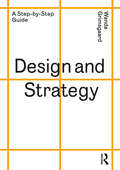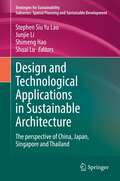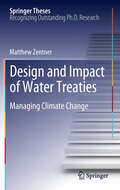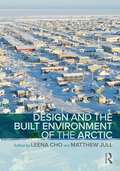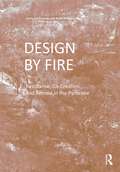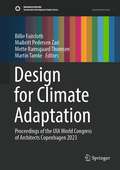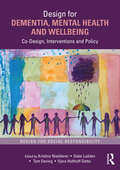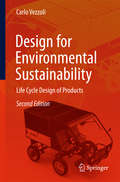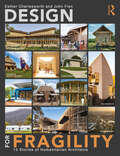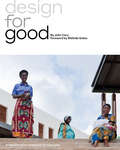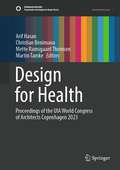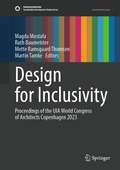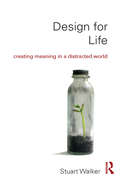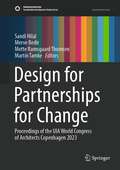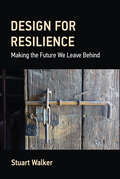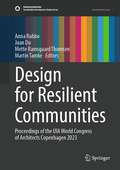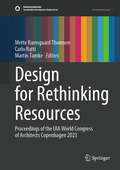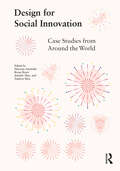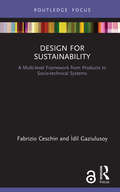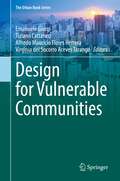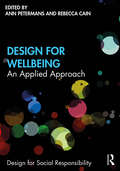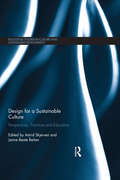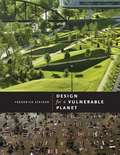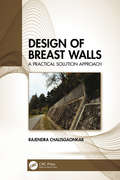- Table View
- List View
Design and Strategy: A Step-by-Step Guide
by Wanda GrimsgaardThis major practical handbook bridges the gap between strategy and design, presenting a step-by-step design process with a strategic approach and extensive methods for innovation, strategy development, design methodology and problem solving. It is an effective guide to planning and implementing design projects to ensure strategic anchoring of the process and outcome. Built around a six-part phase structure that represents the design process, covering initial preparations and project briefing, research and analysis, targets and strategy, concept development, prototyping and modelling, production and delivery, it is a must-have resource for professionals and students. Readers can easily dip in and out of sections, using the phase structure as a navigation tool. Unlike other books on the market, Design and Strategy addresses the design process from the perspective of both the company and the designer. For businesses, it highlights the value of design as a strategic tool for positioning, competition and innovation. For the designer, it teaches how to create solutions that are strategically anchored and deliver successful outcomes for businesses, resulting in appreciative clients. It includes over 250 illustrations and diagrams, tables, and text boxes showing how to move through each stage with clear visualisation and explanation. This book encourages all designers in product design and manufacturing, service design, communication design, branding, and advertising, to think beyond shape and colour to see design through the lens of strategy, process and problem solving, and all business managers, innovators and developers, to see the value in strategic design outcomes.
Design and Technological Applications in Sustainable Architecture: The perspective of China, Japan, Singapore and Thailand (Strategies for Sustainability)
by Shuai Lu Stephen Siu Yu Lau Junjie Li Shimeng HaoThis volume discusses the climate responsiveness of sustainable architecture design and technology in China, Japan, Singapore, and South Korea in recent years, addressing concepts and applications in urban planning, building design, and structural performance evaluation. The four sections of the text cover the theory and implementation of sustainable architecture within various geographic boundaries and contexts, offering an interdisciplinary assessment of the challenges faced in urban areas at different climate zones. The main topics covered are: 1) urban ecological restoration under the influence of climate environment; 2) health and human considerations of building and environment; 3) prototype optimization of sustainable building, and 4) feedback of building performance and design evaluation. The book is intended to be a contribution to the growing body of knowledge on sustainable architecture for applicable use by practitioners, city planners, field researchers, and building operators in building design, construction, usage, operation, and maintenance.
Design and impact of water treaties
by Matthew ZentnerThis study presents a unique way to utilize the existing literature to explain the success of treaties in managing hydrologic stress. Literature-derived core concepts are summarized as seven treaty mechanisms categories (specificity, uncertainty management, enforcement, communications, flexibility, integrativeness, and scale) and are hypothesized as important for shaping the institutional resiliency of a treaty. Treaty design is shown to have a relevant and important role in shaping basin management so that nations may better achieve their goals in a changing climate.
Design and the Built Environment of the Arctic
by Leena Cho Matthew JullDesign and the Built Environment of the Arctic is a concise introductory guide to the design and planning of the built environments in the Arctic region. As the global forces of change are becoming more pronounced in the Arctic, the future trajectories for living environments, city-making processes, and their adaptive capacities need to be addressed directly. This book presents 11 new and original contributions from both leading and emerging scholars and practitioners, positioning the Arctic as a dynamic, diverse, and lived place at the nexus of unprecedented socioenvironmental transformations. The volume offers key concepts for understanding and spatializing Arctic cities and landscapes; similarities and differences in the development of design and planning approaches responsive to specific climatic and cultural conditions; and historical and geographic case studies that provide unique perspectives for the management of the built environment, from the scales of a building and infrastructure to cities and territories. Altogether, the contributions expand regional Arctic design scholarship to understand how the variability of the Arctic context influences the designed urban, architecture, and landscape systems, and offer numerous lessons for design and other forms of spatial practice both within and beyond the Arctic. This is a unique resource for researchers, creative practitioners, policymakers, and community decision-makers, as well as for advanced undergraduate and graduate students.
Design by Fire: Resistance, Co-Creation and Retreat in the Pyrocene
by Emily Schlickman Brett MilliganAcross the world, the risks of wildfires are increasing and expanding. Due to past and current human actions, we dwell in the age of fire – the Pyrocene – and the many challenges and climate adaptation questions it provokes. Exploring our past and current relationships with fire, this book speculates on the pyro futures yet to be designed and cared for. Drawing upon fieldwork, mapping, drone imagery, and interviews, this publication curates 27 global design case studies within the vulnerable and dynamic wildland-urban interface and its adjacent wildlands. The book catalogs these examples into three approaches: those that resist the creative and transformative power of fire and forces of landscape change, those that embrace and utilize those forces, and those that intentionally try to retreat and minimize human intervention in fire-prone landscapes. Rather than serving as a book of neatly packaged solutions, it is a book of techniques to be considered, tested, and evaluated in a time of fire.
Design for Climate Adaptation: Proceedings of the UIA World Congress of Architects Copenhagen 2023 (Sustainable Development Goals Series)
by Mette Ramsgaard Thomsen Martin Tamke Billie Faircloth Maibritt Pedersen ZariThe book provides new perspectives from leading researchers accentuating and examining the central role of the built environment in conceiving and implementing multifaceted solutions for the complex challenges of climate change, revealing critical potentials for architecture and design to contribute in more informed and long-term ways to the urgent transition of our society. The book offers a compilation of peer-reviewed papers that uniquely connects knowledge broadly across practice and academia, from the newest technologies and methods to indigenous knowledge, community engagement, techniques for ecosystem regeneration, nature-based solutions, and more. The book is part of a series of six volumes that explore the agency of the built environment in relation to the SDGs through new research conducted by leading researchers. The series is led by editors Mette Ramsgaard Thomsen and Martin Tamke in collaboration with the theme editors: - Design for Climate Adaptation: Billie Faircloth and Maibritt Pedersen Zari- Design for Rethinking Resources: Carlo Ratti and Mette Ramsgaard Thomsen (Eds.)- Design for Resilient Communities: Anna Rubbo and Juan Du (Eds.)- Design for Health: Arif Hasan and Christian Benimana (Eds.)- Design for Inclusivity: Magda Mostafa and Ruth Baumeister (Eds.)- Design for Partnerships for Change: Sandi Hilal and Merve Bedir (Eds.)
Design for Dementia, Mental Health and Wellbeing: Co-Design, Interventions and Policy (Design for Social Responsibility)
by Kristina Niedderer, Geke Ludden, Tom Dening and Vjera Holthoff-DettoThis edited volume offers the first overview and reflective discussion of how design can contribute to people’s wellbeing and mental health in the context of dementia, mental illness and neurodiversity. This book explores and promotes holistic, salutogenic and preventive strategies that recognise and respond to people’s needs, wants, wishes and rights to further health, wellbeing and equality. Bringing together years of experience as designers and clinicians, the contributors to the book emphasise how design can be a collaborative, creative process as well as an outcome of this process, and they reveal how this is guided by mental health and design policy. Through its three parts, the book explores themes of ethics, citizenship and power relationships in co-design, providing an overview of current developments and approaches in co-design; of the culturally and value sensitive adaptation of design interventions and their applications, many of which are a result of co-design; and of policy and related standards in and for design and mental health. In this way, the book demonstrates how design can help to support people, their care partners and care professionals in promoting mental health and wellbeing, and it offers a rich resource on how to create a sustainable future for care in this domain. The book provides a unique and holistic overview and resource for designers, researchers, students, policy providers and health and care professionals to help support the development and adoption of person-centred design processes and interventions.
Design for Environmental Sustainability: Life Cycle Design Of Products
by Carlo Arnaldo VezzoliThis volume is a technical and operative contribution to the United Nations "Decade on Education for Sustainable Development" (2005-2014), aiding the development of a new generation of designers, responsible and able in the task of designing environmentally sustainable products. The book provides a comprehensive framework and a practical tool to support the design process. This is an important text for those interested in the product development processes.
Design for Fragility: 13 Stories of Humanitarian Architects
by Esther Charlesworth John FienThe demand is now urgent for architects to respond to the design and planning challenges of rebuilding cities and landscapes being destroyed by civil conflict, (un)natural disasters, political instability, and poverty. The number of people fleeing their homes and being displaced by such conflict now totals almost 100 million. Despite the massive human and physical costs of these crises, the number of architects, planners, and landscape architects equipped to work with disaster and development professionals in rebuilding in the aftermath of conflict, floods, fires, earthquakes, typhoons, and tsunamis remains chronically low. Design for Fragility expands the nascent, but rapidly growing field of humanitarian architecture by exploring 13 design responses to such conflict and displacement across 11 countries, including Australia, Bangladesh, Fiji, India, Iran, Pakistan, and the USA. Linked to this displacement is the systemic poverty that often lingers from previous colonial territories and eras, in which many of the featured projects in the book are located. This book follows Charlesworth’s Humanitarian Architecture: 15 Stories of Architects Working After Disasters (Routledge 2014), which analysed the role for architects in exercising ‘spatial agency’ while designing shelter and settlement projects for communities after conflict and disaster. Since that time, the humanitarian architecture movement has expanded globally with the prominence of design agencies including the MASS Design Group and Architecture Sans Frontières (ASF) International. Design for Fragility analyses this role of spatial agency in architecture by addressing diverse conditions of fragility across 13 built projects – from refugee housing in Uganda and an orphanage for teenage girls in Iran to a residential centre in Northern Australia for people with acquired brain injury. Each of the projects profiled in this book explore: The experiences and perceptions of fragility – or precarity – that provided a design challenge and directed the particular spatial response. The specific typology of the project, whether that be a housing, health, children’s, or a First Nations project. The personal values that influenced the architects to work on humanitarian/community projects and how consultation occurred with diverse and often contested project stakeholders. The experiences of the design team as well as project managers, occupants, and donors of the built project, exploring what they deemed successful about the project, and what, if any, were its limitations. Beautifully designed with over 150 illustrations, this practical and inspiring book is for architects, landscape architects, design educators, humanitarian and development aid agencies that are involved, or seeking to be part, of future disaster mitigation and reconstruction strategies and projects, globally.
Design for Good: A New Era of Architecture for Everyone
by John Cary"That's what we do really: we do miracles,” said Anne-Marie Nyiranshimiyimana, who learned masonry in helping to build the Butaro Hospital, a project designed for and with the people of Rwanda using local materials. This, and other projects designed with dignity, show the power of good design. Almost nothing influences the quality of our lives more than the design of our homes, our schools, our workplaces, and our public spaces. Yet, design is often taken for granted and people don't realize that they deserve better, or that better is even possible.In Design for Good, John Cary offers character-driven, real-world stories about projects around the globe that offer more—buildings that are designed and created with and for the people who will use them. The book reveals a new understanding of the ways that design shapes our lives and gives professionals and interested citizens the tools to seek out and demand designs that dignify.For too long, design has been seen as a luxury, the province of the rich, not the poor. That can no longer be acceptable to those of us in the design fields, nor to those affected by design that doesn't consider human aspects.From the Mulan Primary School in Guangdong, China to Kalamazoo College's Arcus Center for Social Justice Leadership, the examples in the book show what is possible when design is a collaborative, dignified, empathic process. Building on a powerful foreword by philanthropist Melinda Gates, Cary draws from his own experience as well as dozens of interviews to show not only that everyone deserves good design, but how it can be achieved. This isn't just another book for and about designers. It's a book about the lives we lead, inextricably shaped by the spaces and places we inhabit.
Design for Health: Proceedings of the UIA World Congress of Architects Copenhagen 2023 (Sustainable Development Goals Series)
by Mette Ramsgaard Thomsen Martin Tamke Arif Hasan Christian BenimanaThe book provides new perspectives from leading researchers accentuating and examining the central role of the built environment in conceiving and implementing multifaceted solutions to the complex challenges of physical and mental health, revealing critical potentials for architecture and design to contribute in more informed and long-term ways to the urgent transition of our society. The volume book offers a compilation of peer-reviewed papers that uniquely connects knowledge and criticality broadly across practice and academia; from new technologies, theories, and methods to community -engaged practice on many scales, and more. The book is part of a series of six volumes that explore the agency of the built environment in relation to the SDGs through new research conducted by leading researchers. The series is led by editors Mette Ramsgaard Thomsen and Martin Tamke in collaboration with the theme editors: - Design for Climate Adaptation: Billie Faircloth and Maibritt Pedersen Zari- Design for Rethinking Resources: Carlo Ratti and Mette Ramsgaard Thomsen (Eds.)- Design for Resilient Communities: Anna Rubbo and Juan Du (Eds.)- Design for Health: Arif Hasan and Christian Benimana (Eds.)- Design for Inclusivity: Magda Mostafa and Ruth Baumeister (Eds.)- Design for Partnerships for Change: Sandi Hilal and Merve Bedir (Eds.)
Design for Inclusivity: Proceedings of the UIA World Congress of Architects Copenhagen 2023 (Sustainable Development Goals Series)
by Mette Ramsgaard Thomsen Martin Tamke Magda Mostafa Ruth BaumeisterThe book provides new perspectives from leading experts examining the role of architects and urbanists in designing for inclusivity in our built environment. By focusing on themes of gender, race and ethnicity, ability, neurodiversity, age, poverty and socio-economy and the non-human, the book tackles the complex challenges that designers and scholars encounter and need to address in their works. The volume offers a diverse compilation of peer-reviewed papers related to architecture for inclusivity in various different formats, ranging from visual essays, argumentative papers and scholastic texts. It presents the notion of "availability", a concept which works to challenge the "othering" inherent in notions of inclusion and accessibility. In its introduction it presents a critical discourse around the challenges and potentials lying in the design for availability targeted towards a systemic change of our societies. The book is part of a series of six volumes that explore the agency of the built environment in relation to the SDGs through new research conducted by leading researchers. The series is led by editors Mette Ramsgaard Thomsen and Martin Tamke in collaboration with the theme editors: - Design for Climate Adaptation: Billie Faircloth and Maibritt Pedersen Zari - Design for Rethinking Resources: Carlo Ratti and Mette Ramsgaard Thomsen (Eds.) - Design for Resilient Communities: Anna Rubbo and Juan Du (Eds.) - Design for Health: Arif Hasan and Christian Benimana (Eds.) - Design for Inclusivity: Magda Mostafa and Ruth Baumeister (Eds.) - Design for Partnerships for Change: Sandi Hilal and Merve Bedir (Eds.)
Design for Life: Creating Meaning in a Distracted World
by Stuart WalkerStuart Walker’s design work has been described as life-changing, inspiring, disturbing and ferocious. Drawing on an extraordinarily diverse range of sources and informed by creative practice, Design for Life penetrates to the heart of modern culture and the malaise that underlies today’s moral and environmental crises. The author argues that this malaise is deep-seated and fundamental to the modern outlook. He shows how our preoccupation with technological progress, growth and the future has produced a constricted view of life – one that is both destructive and self-reinforcing. Based on over twenty-five years of scholarship and creative practice, he demonstrates the vital importance of solitude, contemplation, inner growth and the present moment in developing a different course – one that looks squarely at our current, precarious situation while offering a positive, hopeful way forward – a way that is compassionate, context-based, human scale, ethically motivated and critically creative. Design for Life is an intensely original contribution that will be essential reading for design practitioners and students. Written in a clear, accessible style, it will also appeal to a broader readership, especially anyone who is concerned with contemporary society’s rising inequalities and environmental failings and is looking for a more constructive, balanced and thoughtful direction.
Design for Partnerships for Change: Proceedings of the UIA World Congress of Architects Copenhagen 2023 (Sustainable Development Goals Series)
by Mette Ramsgaard Thomsen Martin Tamke Sandi Hilal Merve BedirArchitecture has played a very important role in colonization of the society and the earth, and today we have the urgent task to crack the theory and practice of this same Architecture. We can achieve this only by working collectively towards reframing concepts that has been at the centre of a dominant universalist western knowledge creation. Rethinking and reframing the ideals of community, participation, commons, agency, design, and land, this book puts forward a collective effort to shift the centre of architectural thinking and practice, and create as many ways possible to understand our role as architects today. We acknowledge unrecognized practices by bringing back everyday-life experiences, different paths and forms of knowledge production and storytelling that inform our understanding of architecture. The book is part of a series of six volumes that explore the agency of the built environment in relation to the SDGs through new research conducted by leading researchers. The series is led by editors Mette Ramsgaard Thomsen and Martin Tamke in collaboration with the theme editors: - Design for Climate Adaptation: Billie Faircloth and Maibritt Pedersen Zari - Design for Rethinking Resources: Carlo Ratti and Mette Ramsgaard Thomsen (Eds.) - Design for Resilient Communities: Anna Rubbo and Juan Du (Eds.) - Design for Health: Arif Hasan and Christian Benimana (Eds.) - Design for Inclusivity: Magda Mostafa and Ruth Baumeister (Eds.) - Design for Partnerships for Change: Sandi Hilal and Merve Bedir (Eds.)
Design for Resilience: Making the Future We Leave Behind
by Stuart WalkerA beautifully written and illustrated framework for resilient design that is as pragmatic as it is inspiring, showing us not only how but why we should design differently.Design for Resilience is a timely, visionary map for creating restorative design that addresses humanity&’s most critical issue: climate change. Our current wealth-oriented economic systems have resulted in gross disparities, war, refugee crises, and mass migrations that augur a bleak collective future. In this book, respected scholar Stuart Walker combines formidable research with practical examples to offer a hopeful, original, and transformative view of what resilient design looks like and how it can apply to all aspects of life, from personal objects to food to culture to business to recreation.Working at the intersection of theory, philosophy, history, environmentalism, and justice, Walker offers a fresh approach that decolonizes design thinking to fundamentally change the nature of design practice and how it shapes our lives, communities, and industries. Asking nothing short of the fundamental question &“How should we live?,&” Design for Resilience addresses the high-priority issues that concern governments, policymakers, designers, and people around the world who recognize that now, perhaps more than at any other time in human history, we need paradigmatic changes to create a future that lasts.
Design for Resilient Communities: Proceedings of the UIA World Congress of Architects Copenhagen 2023 (Sustainable Development Goals Series)
by Mette Ramsgaard Thomsen Martin Tamke Anna Rubbo Juan DuThe book provides new perspectives from leading researchers accentuating and examining the central role of the built environment in conceiving and implementing multifaceted solutions for the complex challenges of creating resilient communities, revealing critical potentials for architecture and design to contribute in more informed and long-term ways to the urgent transition of our society. The volume offers a compilation of peer-reviewed papers that uniquely connects knowledge and criticality broadly across practice and academia; from new technologies, theories and methods to community engaged practice on many scales, and more. The book is part of a series of six volumes that explore the agency of the built environment in relation to the SDGs through new research conducted by leading researchers. The series is led by editors Mette Ramsgaard Thomsen and Martin Tamke in collaboration with the theme editors: - Design for Climate Adaptation: Billie Faircloth and Maibritt Pedersen Zari - Design for Rethinking Resources: Carlo Ratti and Mette Ramsgaard Thomsen (Eds.) - Design for Resilient Communities: Anna Rubbo and Juan Du (Eds.) - Design for Health: Arif Hasan and Christian Benimana (Eds.) - Design for Inclusivity: Magda Mostafa and Ruth Baumeister (Eds.) - Design for Partnerships for Change: Sandi Hilal and Merve Bedir (Eds.)
Design for Rethinking Resources: Proceedings of the UIA World Congress of Architects Copenhagen 2023 (Sustainable Development Goals Series)
by Carlo Ratti Mette Ramsgaard Thomsen Martin TamkeThe book provides new perspectives from leading researchers accentuating and examining the central role of the built environment in conceiving and implementing multifaceted solutions for the complex challenges of our understanding of planetary resources and circularity, revealing critical potentials for architecture and design to contribute in more informed and long-term ways to the urgent transition of our society. The book offers a compilation of peer-reviewed papers that uniquely connects knowledge broadly across practice and academia; from the newest technologies and methods such as the role of digital modelling, analysis, and fabrication in circular design, i.e. material passports, cyber-physical augmentation, and LCA to the potentials of growing and harvesting biomass materials, engaging waste streams in material production and more, all in context of economic, social, and ecological potentials and consequences. The book is part of a series of six volumes that explore the agency of the built environment in relation to the SDGs through new research conducted by leading researchers. The series is led by editors Mette Ramsgaard Thomsen and Martin Tamke in collaboration with the theme editors: - Design for Climate Adaptation: Billie Faircloth and Maibritt Pedersen Zari - Design for Rethinking Resources: Carlo Ratti and Mette Ramsgaard Thomsen (Eds.) - Design for Resilient Communities: Anna Rubbo and Juan Du (Eds.) - Design for Health: Arif Hasan and Christian Benimana (Eds.) - Design for Inclusivity: Magda Mostafa and Ruth Baumeister (Eds.) - Design for Partnerships for Change: Sandi Hilal and Merve Bedir (Eds.)
Design for Social Innovation: Case Studies from Around the World
by Jennifer May Mariana Amatullo Bryan Boyer Andrew SheaThe United Nations, Australia Post, and governments in the UK, Finland, Taiwan, France, Brazil, and Israel are just a few of the organizations and groups utilizing design to drive social change. Grounded by a global survey in sectors as diverse as public health, urban planning, economic development, education, humanitarian response, cultural heritage, and civil rights, Design for Social Innovation captures these stories and more through 45 richly illustrated case studies from six continents. From advocating to understanding and everything in between, these cases demonstrate how designers shape new products, services, and systems while transforming organizations and supporting individual growth. How is this work similar or different around the world? How are designers building sustainable business practices with this work? Why are organizations investing in design capabilities? What evidence do we have of impact by design? Leading practitioners and educators, brought together in seven dynamic roundtable discussions, provide context to the case studies. Design for Social Innovation is a must-have for professionals, organizations, and educators in design, philanthropy, social innovation, and entrepreneurship. This book marks the first attempt to define the contours of a global overview that showcases the cultural, economic, and organizational levers propelling design for social innovation forward today.
Design for Sustainability: A Multi-level Framework from Products to Socio-technical Systems (Routledge Focus on Environment and Sustainability)
by Fabrizio Ceschin İdil GaziulusoyThis book discusses the most significant ways in which design has been applied to sustainability challenges using an evolutionary perspective. It puts forward an innovation framework that is capable of coherently integrating multiple design for sustainability (DfS) approaches developed so far. It is now widely understood that design can and must play a crucial role in the societal transformations towards sustainability. Design can in fact act as a catalyst to trigger and support innovation, and can help to shape the world at different levels: from materials to products, product–service systems, social organisations and socio-technical systems. This book offers a unique perspective on how DfS has evolved in the past decades across these innovation levels, and provides insights on its promising and necessary future development directions. For design scholars, this book will trigger and feed the academic debate on the evolution of DfS and its next research frontiers. For design educators, the book can be used as a supporting tool to design courses and programmes on DfS. For bachelor’s and master’s level design, engineering and management students, the book can be a general resource to provide an understanding of the historical evolution of DfS. For design practitioners and businesses, the book offers a rich set of practical examples, design methods and tools to apply the various DfS approaches in practice, and an innovation framework which can be used as a tool to support change in organisations that aim to integrate DfS in their strategy and processes.
Design for Vulnerable Communities (The Urban Book Series)
by Emanuele Giorgi Tiziano Cattaneo Alfredo Mauricio Flores Herrera Virginia del Socorro Aceves TarangoThis book aims to provide bases for reasoning on what challenges urban-architectural design for vulnerable communities will face in the coming years. Several issues, such as technological development, climate change, political crisis and economic uncertainties show as traditional strategies and methodologies are not sufficient to deeply solve the problems of these complex realities. These new changes, which are studied in different fields of knowledge, highlight the fact that the development of effective solutions must be characterized by multidisciplinary approaches and must be based on strategies promoted by different disciplines. For this reason, this contributed volume collects contributions and considerations from experts in various fields of knowledge working in different parts of the world, such as the Americas, Europe and Asia. The goal is precisely to provide the reader with multidisciplinary knowledge and methodologies in order to better reflect and analyze the challenges that designing for vulnerable communities will face in the next few years. These multidisciplinary studies are organized into five sections: Sustainability and Vulnerabilities in Time of the AnthropoceneApproaches, Principles and Paradigms to Contemporary Research and Practice for Vulnerable CommunitiesDesigning for Vulnerabilities: Applications and ActionsSocial Engagement in Vulnerable Communities Between Digital and Humanist VisionsVulnerabilities in Context: Analysis and Projects in the U.S.-Mexico Border RegionDesign for Vulnerable Communities will be of interest primarily to researchers and professionals in the field of urban-architectural design, but it will also be a useful tool to policy makers and members of civil society at large interested in making cities more inclusive.
Design for Water: Rainwater Harvesting, Stormwater Catchment, and Alternate Water Reuse
by Heather Kinkade-LevarioIn an era of dwindling resources, water is poised to become the new oil. The entire world now faces the reality of a decreasing supply of clean water. To avert a devastating shortage, we must not only look at alternate water sources for existing structures but must plan our new developments differently. Design for Water is an accessible and clearly written guide to alternate water collection, with a focus on rainwater harvesting in the urban environment. The book:* Outlines the process of water collection from multiple sources--landscape, residential, commercial, industrial, school, park, and municipal systems* Provides numerous case studies* Details the assembly and actual application of equipment* Includes specific details, schematics, and referencesAll aspects of rainwater harvesting are outlined, including passive and active system setup, storage, storm water reuse, distribution, purification, analysis, and filtration. There is even a section on rainwater harvesting for wildlife.In addition to rainwater, there are several affordable and accessible alternate sources, including cooling tower bleed-off water, air conditioning condensate, gray water, and fog collection. Design for Water is geared to providing those making development decisions and guidelines with the information they need to set up passive harvesting techniques. The book will especially appeal to engineers, landscape architects, municipal decision-makers, developers, and landowners. Heather Kinkade-Levario is a land-use planner in Arizona and the author of the award-winning Forgotten Rain. She is president of Forgotten Rain L.L.C., a rainwater harvesting and stormwater reuse company.
Design for Wellbeing: An Applied Approach (Design for Social Responsibility)
by Ann Petermans Rebecca CainDesign for Wellbeing charts the development and application of design research to improve the personal and societal wellbeing and happiness of people. It draws together contributions from internationally leading academics and designers to demonstrate the latest thinking and research on the design of products, technologies, environments, services and experiences for wellbeing. Part I starts by conceptualising wellbeing and takes an in-depth look at the rise of the design for wellbeing movement. Part II then goes on to demonstrate design for wellbeing in practice through a broad range of domains from products and environments to services. Among others, we see emerging trends in the design of interiors and urban spaces to support wellbeing, designing to enable and support connectedness and social interaction, and designing for behaviour change to tackle unhealthy eating behaviour in children. Significantly, the body of work on subjective wellbeing, design for happiness, is increasing, and several case studies are provided on this, demonstrating how design can contribute to support the wellbeing of people. Part III provides practical guidance for designing for wellbeing through a range of examples of tools, methods and approaches, which are highly user-centric, participatory, critical and speculative. Finally, the book concludes in Part IV with a look at future challenges for design for wellbeing. This book provides students, researchers and practitioners with a detailed assessment of design for wellbeing, taking a distinctive global approach to design practice and theory in context. Design for Wellbeing concerns designers and organisations but also defines its broader contribution to society, culture and economy.
Design for a Sustainable Culture: Perspectives, Practices and Education (Routledge Studies in Culture and Sustainable Development)
by Astrid Skjerven Janne ReitanAs culture is becoming increasingly recognised as a crucial element of sustainable development, design competence has emerged as a useful tool in creating a meaningful life within a sustainable mental, cultural and physical environment. Design for a Sustainable Culture explores the relationship between sustainability, culture and the shaping of human surroundings by examining the significance and potential of design as a tool for the creation of sustainable development. Drawing on interdisciplinary case studies and investigations from Europe, North America and India, this book discusses theoretical, methodological and educational aspects of the role of design in relation to human well-being and provides a unique perspective on the interface between design, culture and sustainability. This book will appeal to researchers as well as postgraduate and undergraduate students in design and design literacy, crafts, architecture and environmental planning, but also scholars of sustainability from other disciplines who wish to understand the role and impact of design and culture in sustainable development.
Design for a Vulnerable Planet
by Frederick SteinerWe inhabit a vulnerable planet. The devastation caused by natural disasters such the southern Asian tsunami, Hurricanes Katrina and Ike, and the earthquakes in China's Sichuan province, Haiti, and Chile-as well as the ongoing depletion and degradation of the world's natural resources caused by a burgeoning human population-have made it clear that "business as usual" is no longer sustainable. We need to find ways to improve how we live on this planet while minimizing our impact on it. Design for a Vulnerable Planet sounds a call for designers and planners to go beyond traditional concepts of sustainability toward innovative new design that fosters regeneration and resilience. Drawing on his own and others' experiences across three continents, Frederick Steiner advocates design practice grounded in ecology and democracy and informed by critical regionalism and reflection. He begins by establishing the foundation for a more ecological approach to planning and design, adopting a broad view of ecology as encompassing human and natural, urban and wild environments. Steiner explores precedents for human ecological design provided by architect Paul Cret, landscape architect Ian McHarg, and developer George Mitchell while discussing their planning for the University of Texas campus, the Lake Austin watershed, and The Woodlands. Steiner then focuses on emerging Texas urbanism and extends his discussion to broader considerations beyond the Lone Star State, including regionalism, urbanism, and landscape in China and Italy. He also examines the lessons to be learned from human and natural disasters such as 9/11, Hurricane Katrina, and the BP oil spill. Finally, Steiner offers a blueprint for designing with nature to help heal the planet's vulnerabilities.
Design of Breast Walls: A Practical Solution Approach
by Rajendra ChalisgaonkarThe design of breast walls is important parameter for various earth-retaining purposes, and many problems are encountered in the field as a result of improper design and the proper explanation of parameters which influence the technoeconomic designs is required. The book provides insight into the design of retaining walls by explaining the basics of earth pressure theories, the parameters influencing earth pressures, gravity vis-à-vis breast walls and tables and charts for designing stone masonry and concrete breast walls across eight chapters. Details of the analysis are tabulated to aid professional engineers or designers in their practical work. FEATURES Basic principles, design methodology, the influence of various parameters on design and construction features Technoeconomical designs for various combinations of pertinent parameters How to design masonry and concrete walls Design principles and methodologies of designing breast walls with illustrative examples and construction features Design charts and tables for ease of access and a quick design process of breast walls This volume is aimed at professionals in civil engineering, geotechnical engineering, retaining walls, soil mechanics and foundation engineering, as well as engineers working in the highway, water resources and construction sectors.
